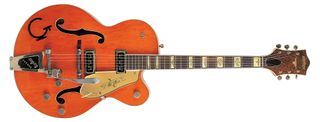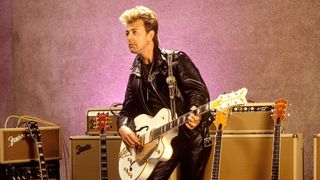While the great misguided assume Pete Townshend used his Gibson SG Specials or numbered and modified Les Paul Deluxes on 70s Who records like Who’s Next and Quadrophenia, old “nose on a stick” was well off solids by that point. His studio guitar of choice was in fact a big orange hollow body 50s Gretsch G6120 Chet Atkins, a gift from old mucker James Gang and Eagles guitarist Joe Walsh.
These days a late 50s G6120 in good nick is a bank-account obliterating vintage dream machine, the ultimate rockabilly guitar beloved by quiffmeisters including Stray Cat Brian Setzer, Jim Heath of Reverend Horton Heat and icons like twang genius Duane Eddy and doomed teen idol Eddie Cochran. For Pete Townshend however, his first eyeball full of that old guitar didn’t exactly pump his gnads…
As he remarked to Guitar Player magazine in 1972: “I said, ‘Great, cheers, man’. I was being polite. I opened the case and it was bright orange and I thought, ‘Ugh! It’s horrible, I hate it.’ I went home and went into my studio and plugged it in and it totally wrecked me out, it’s the best guitar I’ve got now.”
Townshend is no vintage geek and over the years he consistently fucked up the nerdy details about the guitar when quizzed by magazines. It was a ‘57 model, he said. Nope. It had ‘58 onward Filter’Tron humbucking pickups, and a ‘59/‘60 spec V-cut Bigsby vibrato. Pete also, on occasion, claimed it was a “Country Gentleman”. Wrong again. What he had was the “Chet Atkins” model. Yes, the G6122 Country Gentleman - as made iconic by George Harrison at the height of Beatlemania - is a Chet Atkins model but it had a slimmer body than the G6120and simulated, painted on f-holes.
What Pete did know was the big Gretsch sounded the absolute business when combined with his Edwards pedal steel volume pedal, Whirlwind cable and ’59 Fender 3x10 Bandmaster amplifier… all gifts from Mr Generous, Joe Walsh.
It’s weird that Pete didn’t take to the Gretsch’s looks. As an longtime Eddie Cochran fan - The Who famously covered the dead rocker’s Summertime Blues - he must’ve known of his idol’s deep affection for the G6120. Cochran was a nice kid who just happened to release the first real punk records; a fact not lost on Pistols manager Malcolm McLaren when he had Sid Vicious record a couple of Cochran’s tunes. Eddie cut his fair share of schmaltzy luvvie duvvie stuff too but tracks like Summertime Blues, C’mon Everybody, Somethin’ Else and Nervous Breakdown were the first 45s chronicling teenage rebellion. Even the lighthearted Twenty Flight Rock had an undercurrent of sexual frustration in its lyrics. When he claimed he was too tired to “rock” with his girl after he climbed all those stairs, the kids got what he really meant.
The electric tone on those records was all Gretsch. Cochran bought his G6120 from Bell Gardens Music in Bell Gardens, California, in 1955 when he was just 16. Already a superb guitarist - way more gifted than his hit 45s suggest - Eddie set about pimping the Gretsch to suit his own tastes. Like most guitar-obsessed kids at the time, Eddie was a fan of Chet Atkins but that didn’t mean he wanted the man’s name plastered on his guitar. He soon scratched the gold paint and the Atkins signpost logo off the underside of his guitar’s pickguard, leaving the Perspex completely transparent. Eddie also replaced the G6120’s neck pickup - a singlecoil DeArmond - with a “dog-ear” Gibson P90.
Aside from those details Eddie’s Gretsch was classic first generation G6120. First released in 1954, the guitar was designed with input from country jazz guitarist Chet Atkins. One of the most gifted guitarists who ever lived, Atkins was one of the architects of “The Nashville Sound”, a gentrification of country music using piano and strings that rescued the genre from annihilation by rock’n’roll and recut it for a adult audience.
Chet’s new guitar had a 16” wide, 2 7⁄8” deep laminated maple body with bound f-holes, a 24.5” scale maple neck and 9” radius rosewood fingerboard. In case there was any doubt that this was a country guitar, the G6120 featured block fingerboard inlays engraved with cacti and steer horns, a Longhorn headstock inlay and a G brand burned into the guitar’s top. In 1956, Gretsch toned down the cowboy shizzle with plain fingerboard inlays and a more subtle horseshoe logo for the headstock.
The Chet Atkin’s retained its singlecoil DeArmond pickups until 1958 when the model received a pair of the new Filter’Tron humbuckers. The latter pups consolidated the classic twang produced by their predecessors but with more output and less background noise. The following years saw the inlays change from block to Neo-Classical and body depth reduce until late 1961 when Gretsch switched the 6120 from a single to a double cutaway format, thus ensuring that the original 50s guitars would always be prettier and way more desirable.

Eddie Cochran probably wouldn’t have taken to the new design. But then, he didn’t live to see it. The kid loved his guitar - seriously - and it rarely left his side from the day he bought it in 1955 to the night he died in a car crash near Bath, U.K. in 1960. His Gretsch was recovered undamaged from the boot and returned to his family. It’s now in the Rock ‘N’ Roll Hall Of Fame in Cleveland, Ohio.
With respect to Chet Atkins, Eddie Cochran and Pete Townshend, the man who really put the Gretsch G6120 on the map is Stray Cat Brian Setzer. It’s thanks to this guy that the big orange Gretsch is considered the iconic rockabilly guitar. The fact is, not many rockabilly cats from the 50s used Gretsch guitars. Carl Perkins used a Gibson Les Paul; Luther Perkins played the boogie with Johnny Cash on his mid-50s Fender Esquire. Paul Burlison of the Rock And Roll Trio cut records like Train Kept A-Rollin’ on a Telecaster.
In truth, Setzer was more influenced musically by the licks and rapid runs of Gene Vincent & His Blues Caps guitarist Cliff Gallup, an incredibly gifted Gretsch Duo Jet player who also lit a fire under Jeff Beck. But Brian Setzer thought Cochran was the package. The blond quiff. The big orange guitar. Said Brian: “It wasn’t just music with him; it was his guitar playing, his look, his singing, I’d say that, all things considered, he’s probably my favourite “cat” of all time.”
- The Guitars That Built Rock: The Rickenbacker 330
- The Guitars That Built Rock: The Gibson ES-335
- The Guitars That Built Rock: The Fender Telecaster
- The Guitars That Built Rock: The Gibson Les Paul Junior
Setzer bought his first G6120, the ‘59 Strat Cat guitar, in the late 70s when he was 17. This was the era of Eddie Van Halen, pimped Strats and back-combed lady boys tottering along the Sunset Strip. Rockabilly and old Gretsch guitars were dead and Brian picked up the orange behemoth that changed his life for a measly $100. Thanks to Setzer and the records he cut with Stray Cats drummer “Slim Jim” Phantom and bassist Lee Rocker, vintage Gretsch guitars rocketed in value, and the company was eventually revived in the 1990s.
These days, Setzer’s name adorns the headstocks of a bunch of G6120-based signature models. And if you had to pick one song that kickstarted that Gretsch heartbeat into life, and captured the perfect rockabilly guitar sound, it’s the band’s classic 1981 single Stray Cat Strut. If this doesn’t get you hooked on Gretsch, there’s no hope for you…


